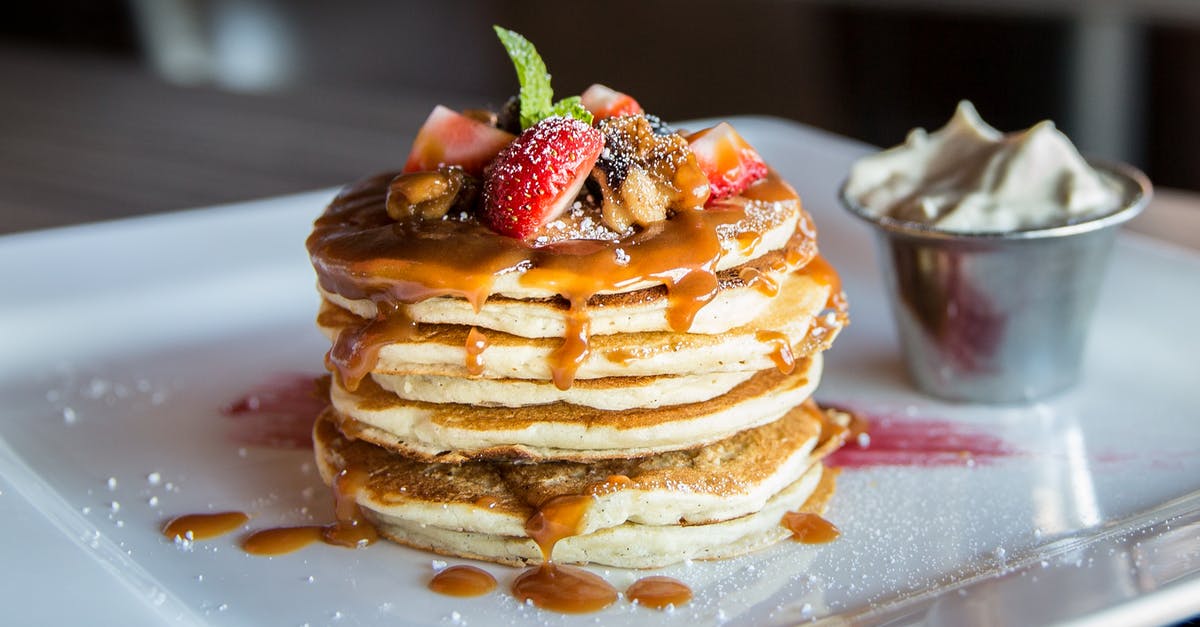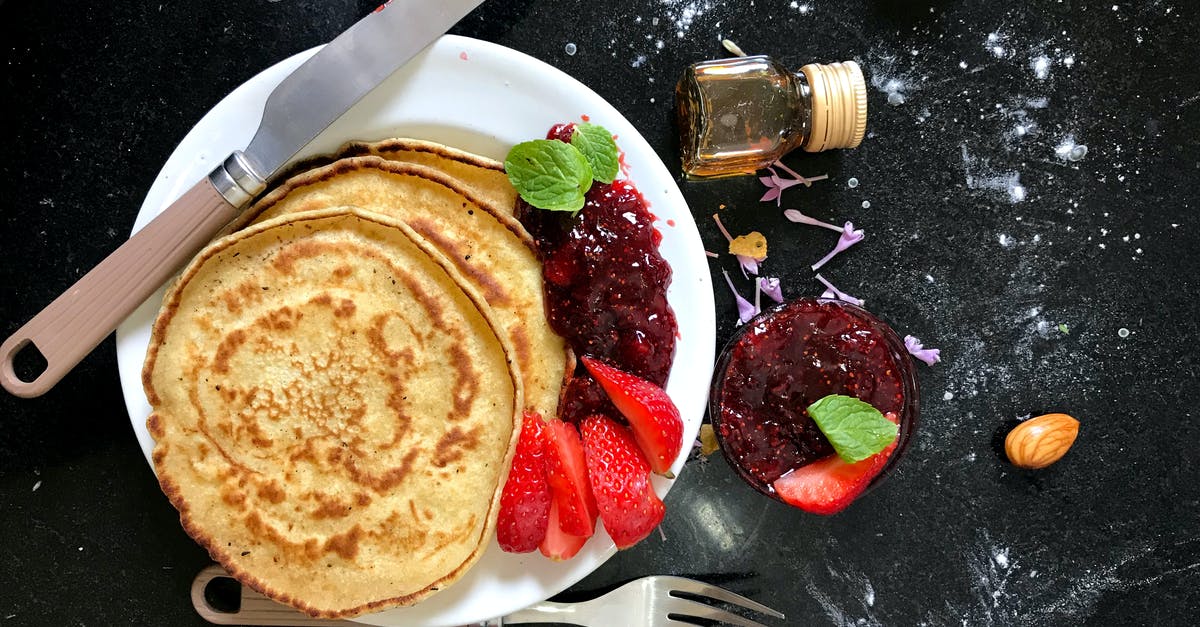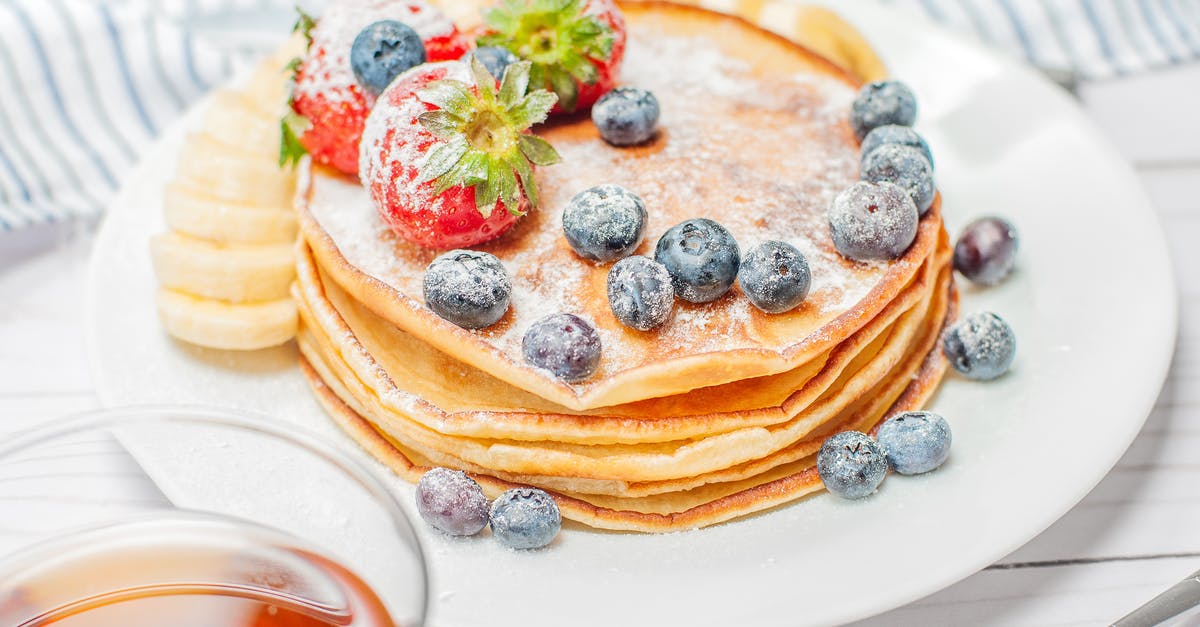Why do my pancakes fizz?

TL;DR: Usual pancake (French-style crepe) mixture causes separation of the mixture in the blender and fizzes when fried resulting in very poor quality pancakes which burn easily.
The last couple of weeks I made flat (not fluffy) pancakes with this recipe:
- 500ml semi-skimmed milk (green top for those in the UK)
- approx 200ml gluten-free flour (it was tipped in without measuring, but that's how I always do it) - by volume this would be about 1/3 of the milk measure
- 2 fresh medium eggs (bought the day before, stored in the fridge)
- 1/2 tbsp of vanilla essence, aka a 'splash'
The method?.. Stick it all in a blender, run for 10 seconds, scrape/scoop any unmixed flour from the sides, run for another 5 seconds, fry (no oil.)
Last week I got a really nice, thin, medium-golden set of pancakes. Literally, every single one cooked beautifully in seconds, curled at the edges just so I could flip, was thin, tasty, and perfect.
This week the mixture fizzed (yes, 'fizzed') as it hit the pan. The holes appearing as it fried were huge and at the edges, it seemed to stick straight to the pan and just burn straight away. It did not curl and I had to get the spatula (thin, metal) forced under the edges to be able to peel them and flip. The underside burnt and until the mixture cook firm the liquid mixture continued to make the disturbing fizzing. Just before flipping, I could see a sort of mottling on the top, completely unlike any pattern a regular pancake would have. After flipping the second side would not brown at all - just go from white to burnt. They tasted OK, but not like last weeks'.
This is how I always make pancakes, but every so often they come out with this irritating 'fizz' sort of sound and it's at that moment I know they are going to be a pain to fry.
The one other indicator I get is that when I finish blending the mixture together, the top is bubbly and clearly separate from the regular part of the mixture. I just can't figure out why it would separate like this - what is the cause of the low-quality mixture? The ingredients are always bought within a couple of days of making and I've had great success with relatively older ingredients. I have had limited success by removing the frothy mixture from the top of the blender, but even the better mixture at the bottom does not produce great pancakes.
PS: Yes, I wish I'd taken a photo or two but I was so stressed by it happening again I just didn't. Sorry.
Best Answer
I don't have much experience of cooking with gluten-free flour so can't comment on any degree to which that might be a factor. I would generally let a pancake batter sit for at least 15 minutes before use to let the flour fully absorb the liquid, which may be less necessary with gluten-free flour.
However, there are three main things that leap out at me from the description as being possible sources of the problem:
- The recipe: pancake batter is quite thin normally, if you push the balance too far towards liquids, the batter can't form a cohesive pancake because the flour mix is too dilute, the bonds can't be formed. It will eventually form a solid, but not until the heat has driven off the excess liquid. Your recipe already has a higher proportion of liquid than most UK recipes I've seen, and also less egg for the amount of batter than many. Obviously, it works for you some of the time, which leads us to the next point...
- Not measuring flour: Your recipe is for a pretty thin batter, that reduces the tolerance within which under-measuring still lets the batter function. I suspect that the times you see what you describe as 'separation' is when there just isn't enough flour to thicken the liquid.
- Pan temperature. What you describe as 'fizzing' may be what others would just call sizzling, the mixture hit the hot pan surface and the liquid in it quickly turns to steam, causing the bubbles. This is going to be more pronounced the higher the proportion of liquid in your batter.
A minor thing is that in my experience some thing s work better if you just whisk them together rather than using the chopping motion of the blades in a blender. I'd put pancake batter in that category, but that may be just personal preference.
I recommend that
- you start measuring the flour to ensure that you achieve a consistent batter
- Use a small amount of batter to test the temperature of the pan before you start making the pancakes proper.
- Try whisking rather than blending and resting the batter, though I think these are less likely to make a difference.
My personal preference would always be to cook pancakes in a buttered pan too. One of the benefits of that, apart from the flavour, is that because butter burns if the pan is too hot, you have to keep the pan temperature lower and that is generally a good thing for pancakes.
Pictures about "Why do my pancakes fizz?"



Quick Answer about "Why do my pancakes fizz?"
TL;DR: Usual pancake (French-style crepe) mixture causes separation of the mixture in the blender and fizzes when fried resulting in very poor quality pancakes which burn easily.How do you stop pancakes from bubbling?
If a bubble comes to the surface, pops, but is filled in by more pancake batter, hold off on flipping. Make sure your pancakes are hole-y! Chances are, you've probably smeared pancake batter because of a sloppy flip.Why do my pancakes puff up?
Too much baking powder will create a very puffy pancake with a chalky taste, while too little will make it flat and limp. Baking soda rises only once when exposed to an acid (like buttermilk, sour cream, or yogurt). Baking soda also controls the browning of the batter in the pan.Are pancakes supposed to bubble?
That precise moment indicates the pancake is in the state of changing from a liquid to a gel, and bubbles are the best way to tell. Pancakes are fairly easy to make. They can include flour, sugar, butter, an egg, salt, milk, and some combination of baking soda and an acid.When to Flip Pancakes - Perfect Pancakes Every Time!
More answers regarding why do my pancakes fizz?
Answer 2
I have accepted @spagirl's answer as it provided the best information, but I also want to provide a description of what I have done to produce successful pancakes - the original question doesn't seem the right place...
Though @spagirl has provided some great information which I took account of this past weekend, I believe I have nailed the method and that the recipe in my question is good.
This past weekend I tried again and very successfully made about 10 thin (crepe-style), light, tasty pancakes without burning (or sacrificing!) even one of them! Very happy I am. Yes.
So, having achieved really great pancakes here are the detractors and significant details:
- Oil - Not used oil at all
- Water - I heated the pan a little to make sure any excess moisture was removed, but otherwise just used a kitchen towel (paper)
- Recipe - Exactly the same as in my original description
- Measurements - I measured after adding what I thought was correct (more for future reference, but also to check that I was getting something akin to the 3-2-1 ratios)
- Standing - The only stand time the mixture got after blending was the perhaps 30-60 seconds it took me to light the pan and grab a spatula.
- Temperature - This was the biggest change to the method: I lit the gas under the pan, set it to the lowest setting, and poured the first pancake in straight away, tilting the pan to spread it out evenly. I then increased the heat to about 1/3 of the maximum temperature of the ring. (It is a double ring, with an outer and an inner gas ring - so can produce much hotter pans than my other rings.)
Other than the above there was no change. Having said that, the detail for #4 Measurements is:
- Put 0.35 litres of 2% milk (regular semi-skimmed UK) in the blender
- Dropped in 2 eggs and a splash of vanilla essence
- Placed the blender on the digital scales, set it to 0, and added 175g of gluten-free flour
- Blended on high for about 10 seconds (until it looked mixed in - including time to scrape extra bits from the sides)
As I said, I don't believe that I've done anything differently - the measuring of flour was done after adding it by eye - and the only significant change was heating the pan to the required temperature after the first pancake's batter was in the pan.
Answer 3
From what you've described, I'd recommend three changes:
- Let the mixture sit 15 to 30 minutes before cooking it. Gluten-free flour needs time to hydrate. If you don't, you can get the separation that you describe (as it didn't absorb the moisture fully), and it can be gritty. It's also a good practice with regular flour to let it sit for a few minutes, as that will let the bubbles that get whipped in from the blender a chance to escape. (although the 'fizzing' might also be free liquid that's evaporating and causing extra bubbling)
- Make sure the pan is up to temperature. If it weren't a non-stick pan, I'd recommend using the Leidenfrost effect. For non-stick, I'd cook a small 'sacrificial pancake' to determine if the heat is correct.
- Grease the pan. 'Non-stick' is more like 'stick resistant'. Use a paper towel (piece of kitchen roll?) to spread a really thin layer (basically, put it on, then wipe it all off), so you're less likely to stick, but won't end up frying the pancakes in fat. Heating up a teflon pan dry can lead to damage from overheating (and killing any exotic birds in the house), so always heat it up with a little bit of oil in it so you have an indicator when it's getting hot.
You might also want to look for gluten-free specific recipes, as not all gluten free flours are best for all types of baked goods. There are many 'pancakes' of the style that you like in other countries, so you can widen your range (and be less likely to have to dig through American pancake recipes)
Answer 4
I've used Dove's Farm and Sainsbury's own gluten free flour for pancakes (crepe and American) with little problem. However, I wonder if the blender isn't very efficient at mixing everything very well. Pancakes work best by gradually adding wet ingredients to dry and whisking it in until smooth. Blenders aren't really made with that in mind.
The other is the lack of oil in the pan.
I mix by hand, gradually adding the wet to dry ingredients and then letting it rest for about ten minutes, a dab of oil on a clean kitchen towel and a medium heat is all I need for about three pans of pancakes (drop scones are bite sized American pancakes).
Sources: Stack Exchange - This article follows the attribution requirements of Stack Exchange and is licensed under CC BY-SA 3.0.
Images: EKATERINA BOLOVTSOVA, Ash, Rama Khandkar, Dmytro
